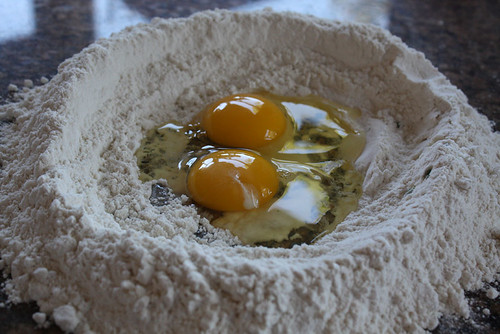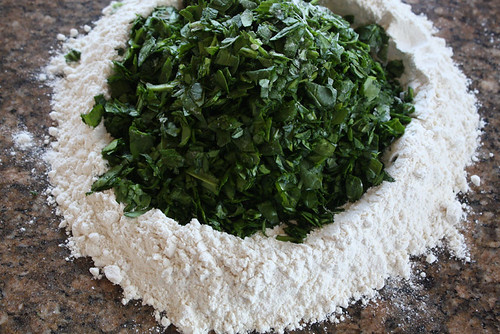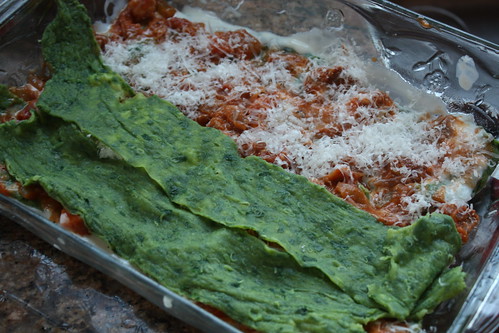Spinach Lasagne with Ragu alla Bolognese
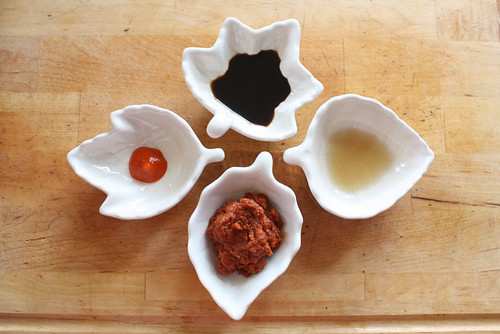 I think it’s fair to say that I equally enjoy baking sweets as much as I enjoy cooking something savory. Regardless of what it is, I normally rise to a challenge and can’t think of a better way to spend a day in the kitchen because the end product can be so rewarding. Although most of the past Daring Bakers’ challenges have been of the sweet variety, this month, we had a rare opportunity to bake something somewhat unexpected: Lasagna.
I think it’s fair to say that I equally enjoy baking sweets as much as I enjoy cooking something savory. Regardless of what it is, I normally rise to a challenge and can’t think of a better way to spend a day in the kitchen because the end product can be so rewarding. Although most of the past Daring Bakers’ challenges have been of the sweet variety, this month, we had a rare opportunity to bake something somewhat unexpected: Lasagna.
I’m certainly not new to lasagna, and true to my passions as a cook, I’m not sure I’ve ever made lasagna the same way twice. No, really. It must be because there are too many wonderful recipes out there to try, and each one poses a sort of opportunity to find the perfect one. And guess what? I think we’ve decided that it’s been found. Who knew that it didn’t need to be packed with ricotta and mozzarella? Well, okay, I did, because I have made lasagna with mushrooms and a bechamel. But I’ve only made my own pasta once, and I’ve never made spinach pasta.
The March 2009 challenge is hosted by Mary of Beans and Caviar, Melinda of Melbourne Larder and Enza of Io Da Grande. They have chosen Lasagne of Emilia-Romagna from The Splendid Table by Lynne Rossetto Kasper as the challenge.
Many thanks to all the hosts, as I enjoyed this challenge quite a bit — both process and product!
There were several parts to this challenge, but in a nutshell they were to: 1) make a meat ragu sauce; 2) make the lasagna pasta by hand; 3) make a bechamel; and 4) make the lasagna, of course. The choice factor was to make a ragu different from the one provided, and that’s exactly what I did.
Suffice it to say that amidst my husband’s unwavering focus on the first big week of March Madness, I spent the day in my kitchen preparing this absolutely yummy dish. My Ragu alla Bolognese, inspired by a version presented in Saveur that in turn was inspired by British chef Heston Blumenthal, was completely delicious — and I didn’t have to go to the grocery store for one ingredient. Miraculous.
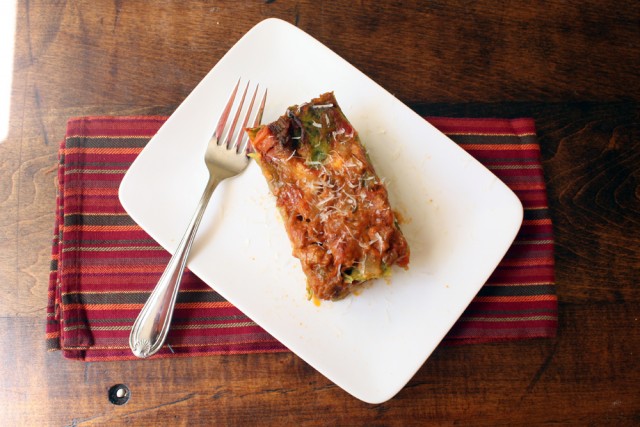
I made the Ragu first:
My Own Ragu alla Bolognese
1-3/4 lbs. pork shoulder, trimmed and chopped into 1/4″ pieces
1 tsp. dried thyme
3 sprigs flat-leafed parsley
2 bay leaves
1 tsp. fresh tarragon, chopped
5 T extra virgin olive oil
4 small red onions, chopped
2 medium carrots, chopped
2 stalks celery, chopped
4 cloves garlic, minced
2 pieces star anise
1 tsp. ground corriander
32 oz. good canned tomatoes, chopped
1/2 c. dry white wine
2 T sun dried tomato paste, double concentrated
2 tsp. worcestershire sauce
1/4 tsp. fish sauce
1/4 tsp. sriracha hot sauce
1 c. milk
sea salt
fresh coarsely ground pepper
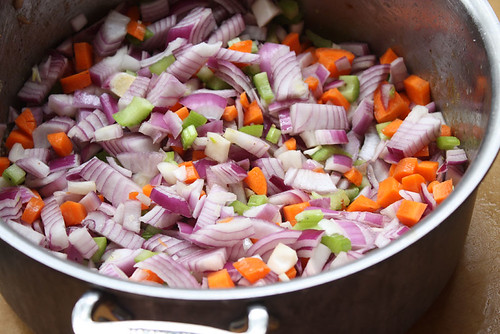
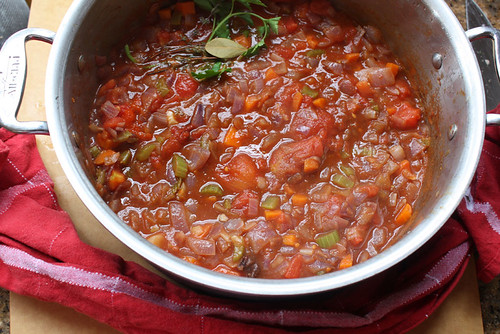
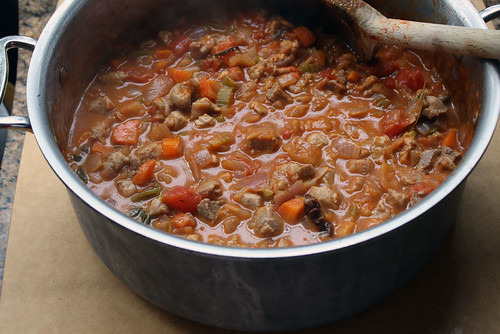
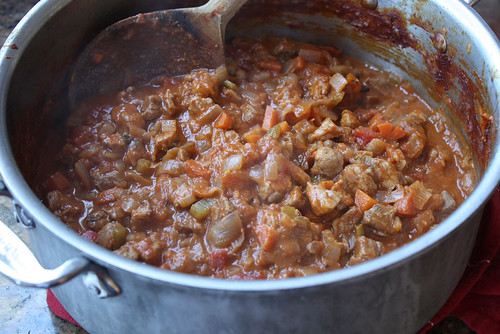
In a large deep pan, or Dutch oven, heat 3 T of the olive oil and add the chopped pork. Sprinkle with salt and pepper and cook, stirring occasionally until browned, about 10 minutes depending on the area in your pan. Remove the meat and set aside in a small bowl.
In the same pan, heat the remaining 2 T of olive oil, and add the onions, carrots, celery, garlic, star anise, and ground coriander. Stir occasionally, cooking until browned about 15 minutes. Pour in the wine, stirring until completely evaporated, scraping up any browned bits from the bottom and sides of the pan.
Add the herbs, tomatoes, tomato paste, worcestershire sauce, fish sauce, and Sriracha. Mix to combine ingredients and season with salt and pepper. Over medium heat, cook the mixture 15 minutes, then add the milk and the pork. Bring to a simmer and reduce heat to low, keeping a slow simmer until the sauce is very thick, at least 3 hours. Keep the pan partially covered. If necessary, add water in very small quantities to keep the sauce from getting too thick. Correct seasoning before serving.
My Notes:
- To make cutting the pork easier, make sure it’s slightly frozen. This will save you an amazing amount of time and patience.
- Try to avoid overcrowding the pan when browning the pork. You don’t need to caramelize the pieces, but you don’t want to boil them, either.
- Include all the juice from the canned tomatoes. The entire quantity of tomatoes and liquid should equal 32 oz. The better the quality tomatoes, the better tasting your sauce will be.
- I used a very dry Chardonnay to deglaze the pan.
- Fish sauce comes in many varieties and can be found in the Asian section of your grocery store. I use Pastel which is a brand produced in the Philippines. It adds flavor to a variety of dishes.
- Sriracha is an Asian hot sauce. It’s very hot. Use any kind of hot sauce you’d like, but use it to give the sauce a nice little kick like a puttanesca.
- No cheating on the cooking time. Keep that heat low, and the pan almost completely covered, and you may only need to add about 1/2 c. water to achieve a lovely consistency perfect for tossing with pasta, or for use in this lasagna.
Then I made the pasta completely without the assistance of my beloved Kitchen Aid, Bertha: All recipes below from The Splendid Table: Recipes from Emilia-Romagna, the Heartland of Northern Italian Food by Lynne Rossetto Kasper (published by William Morrow and Company Inc., 1992).
Spinach Egg Pasta (Pasta Verde)
Preparation: 45 minutes
Makes enough for 6 to 8 first course servings or 4 to 6 main course servings, equivalent to 1 pound (450g) dried boxed pasta.
2 jumbo eggs (2 ounces/60g or more)
10 ounces (300g) fresh spinach, rinsed dry, and finely chopped; or 6 ounces (170g) frozen chopped spinach, defrosted and squeezed dry
3&1/2 cups (14 ounces/400g) all purpose unbleached (plain) flour (organic stone ground preferred)
Working by Hand:
Equipment
- A roomy work surface, 24 to 30 inches deep by 30 to 36 inches (60cm to 77cm deep by 60cm to 92cm). Any smooth surface will do, but marble cools dough slightly, making it less flexible than desired.
- A pastry scraper and a small wooden spoon for blending the dough.
- A wooden dowel-style rolling pin. In Italy, pasta makers use one about 35 inches long and 2 inches thick (89cm long and 5cm thick). The shorter American-style pin with handles at either end can be used, but the longer it is, the easier it is to roll the pasta.
- Plastic wrap to wrap the resting dough and to cover rolled-out pasta waiting to be filled. It protects the pasta from drying out too quickly.
- A sharp chef’s knife for cutting pasta sheets.
- Cloth-covered chair backs, broom handles, or specially designed pasta racks found in cookware shops for draping the pasta.
Mixing the dough:
Mound the flour in the center of your work surface and make a well in the middle. Add the eggs and spinach. Use a wooden spoon to beat together the eggs and spinach. Then gradually start incorporating shallow scrapings of flour from the sides of the well into the liquid. As you work more and more flour into the liquid, the well’s sides may collapse. Use a pastry scraper to keep the liquids from running off and to incorporate the last bits of flour into the dough. Don’t worry if it looks like a hopelessly rough and messy lump.
Kneading:
With the aid of the scraper to scoop up unruly pieces, start kneading the dough. Once it becomes a cohesive mass, use the scraper to remove any bits of hard flour on the work surface – these will make the dough lumpy. Knead the dough for about 3 minutes. Its consistency should be elastic and a little sticky. If it is too sticky to move easily, knead in a few more tablespoons of flour. Continue kneading about 10 minutes, or until the dough has become satiny, smooth, and very elastic. It will feel alive under your hands. Do not shortcut this step. Wrap the dough in plastic wrap, and let it relax at room temperature 30 minutes to 3 hours.
Stretching and Thinning:
If using an extra-long rolling pin work with half the dough at a time. With a regular-length rolling pin, roll out a quarter of the dough at a time and keep the rest of the dough wrapped. Lightly sprinkle a large work surface with flour. The idea is to stretch the dough rather than press down and push it. Shape it into a ball and begin rolling out to form a circle, frequently turning the disc of dough a quarter turn. As it thins outs, start rolling the disc back on the pin a quarter of the way toward the center and stretching it gently sideways by running the palms of your hands over the rolled-up dough from the center of the pin outward. Unroll, turn the disc a quarter turn, and repeat. Do twice more.
Stretch and even out the center of the disc by rolling the dough a quarter of the way back on the pin. Then gently push the rolling pin away from you with one hand while holding the sheet in place on the work surface with the other hand. Repeat three more times, turning the dough a quarter turn each time.
Repeat the two processes as the disc becomes larger and thinner. The goal is a sheet of even thickness. For lasagne, the sheet should be so thin that you can clearly see your hand through it and see colours. Cut into rectangles about 4 by 8 inches (10 x 20 cm). Note: Enza says that transparency is a crucial element of lasagne pasta and the dough should be rolled as thinly as possible. She says this is why her housekeeper has such strong arms!
Dry the pasta at room temperature and store in a sealed container or bag.

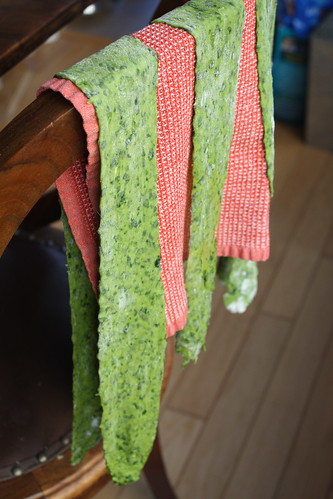
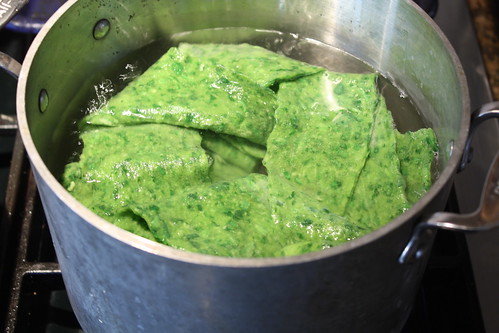

My Notes:
- The recipe calls for jumbo eggs and I only had extra large, so I added an additional egg after I tried unsuccessfully to incorporate the ingredients into any kind of dough. It was just a pile of flour coated spinach. I cracked the extra egg into the pile you see above.
- I used raw, chopped, unblanched spinach for the pasta. This was a completely interesting experience and I did check the directions a number of times just to make sure I didn’t have to cook it.
- The pasta rolls out beautifully — even on my cool temperature granite countertops. A light sprinkling of flour kept the dough from sticking.
- I rolled the pasta very thin, but there was no way that the color of my hand would be visible through it. Too much spinach!
- The pasta pieces stretched while hanging over the chair backs so I had plenty for the lasagna and more left over that I froze.
- Boil the pasta in very salty water only briefly, then scoop out and drop in a pan of very cold water. Works perfectly!
While the pasta was drying, I made the bechamel:
Bechamel
Preparation Time: 15 minutes
4 tablespoons (2 ounces/60g) unsalted butter
4 tablespoons (2 ounces/60g) all purpose unbleached (plain) flour, organic stone ground preferred
2&2/3 cups (approx 570ml) milk
Salt and freshly ground pepper to taste
Freshly grated nutmeg to taste
Using a medium-sized saucepan, melt the butter over low to medium heat. Sift over the flour, whisk until smooth, and then stir (without stopping) for about 3 minutes. Whisk in the milk a little at a time and keep the mixture smooth. Bring to a slow simmer, and stir 3 to 4 minutes, or until the sauce thickens. Cook, stirring, for about 5 minutes, until the sauce thickens. Season with salt, pepper, and a hint of nutmeg.
My Notes:
- Very straight forward recipe for a lovely bechamel. No secrets or problems, but I’ve made bechamel many, many times, so didn’t expect surprises.
And then I put the lasagna together:
Lasagne of Emilia-Romagna (Lasagne Verdi al Forno)
(Serves 8 to 10 as a first course, 6 to 8 as a main dish)
Preparation Time: 15 minutes to assemble and 40 minutes cooking time
10 quarts (9 litres) salted water
1 recipe Spinach Pasta cut for lasagna
1 recipe Bechamel Sauce
1 recipe My Ragu alla Bolognese
1 cup (4 ounces/125g) freshly grated Parmigiano-Reggiano
Method
Working Ahead:
The ragu and the béchamel sauce can be made up to three days ahead. The ragu can also be frozen for up to one month. The pasta can be rolled out, cut and dried up to 24 hours before cooking. The assembled lasagne can wait at room temperature (20 degrees Celsius/68 degrees Fahrenheit) about 1 hour before baking. Do not refrigerate it before baking, as the topping of béchamel and cheese will overcook by the time the center is hot.
Assembling the Ingredients:
Have all the sauces, rewarmed gently over a medium heat, and the pasta at hand. Have a large perforated skimmer and a large bowl of cold water next to the stove. Spread a double thickness of paper towels over a large counter space. Preheat the oven to 350 degrees Fahrenheit (180 degrees Celsius). Oil or butter a 3 quart (approx 3 litre) shallow baking dish.
Cooking the Pasta:
Bring the salted water to a boil. Drop about four pieces of pasta in the water at a time. Cook about 2 minutes. If you are using dried pasta, cook about 4 minutes, taste, and cook longer if necessary. The pasta will continue cooking during baking, so make sure it is only barely tender. Lift the lasagne from the water with a skimmer, drain, and then slip into the bowl of cold water to stop cooking. When cool, lift out and dry on the paper towels. Repeat until all the pasta is cooked.
Assembling the Lasagne:
Spread a thin layer of béchamel over the bottom of the baking dish. Arrange a layer of about four overlapping sheets of pasta over the béchamel. Spread a thin layer of béchamel (about 3 or 4 spoonfuls) over the pasta, and then an equally thin layer of the ragu. Sprinkle with about 1&1/2 tablespoons of the béchamel and about 1/3 cup of the cheese. Repeat the layers until all ingredients are used, finishing with béchamel sauce and topping with a generous dusting of cheese.
Baking and Serving the Lasagne:
Cover the baking dish lightly with foil, taking care not to let it touch the top of the lasagne. Bake 40 minutes, or until almost heated through. Remove the foil and bake another 10 minutes, or until hot in the center (test by inserting a knife – if it comes out very warm, the dish is ready). Take care not to brown the cheese topping. It should be melted, creamy looking and barely tinged with a little gold. Turn off the oven, leave the door ajar and let the lasagne rest for about 10 minutes. Then serve. This is not a solid lasagne, but a moist one that slips a bit when it is cut and served.
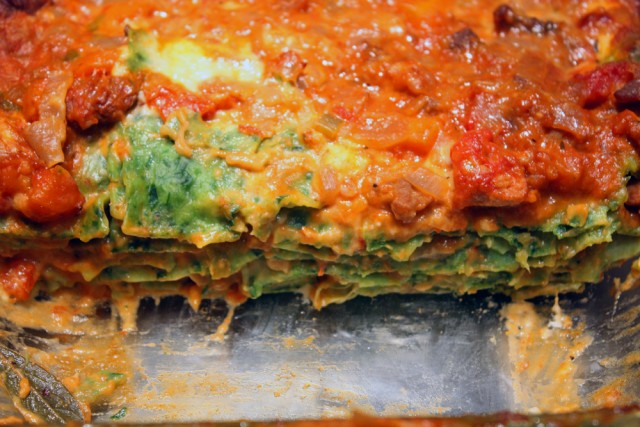
My Notes:
- I was perfect this time (right) and followed the directions to a tee. If you’ve made lasagna a hundred times, it’s basic.
- My lasagna was completely solid and did not slip one single bit. Outside of letting a bit of time pass because I had to take a few photos, we ate it almost immediately.
- It’s creamy and flavorful, moist and satisfying — yes, even without the melting fatty mess of cheese usually found in lasagna recipes. Truly very nice.
- We enjoyed it the next night for dinner, too, and then I cut it into pieces and froze each in a separate ziplock bag.
- I’d definitely make this entire recipe again right down to rolling the pasta. It deserves a special occasion instead of just the three of us on a Sunday at home watching March Madness. Can life get any better than that? Come on. Think about it.
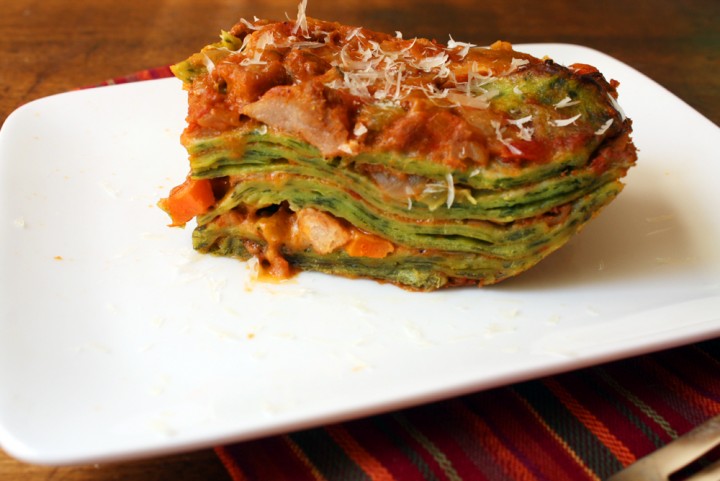
And if you haven’t checked out the new Daring Kitchen, please do — there’s quite a bit going on there these days!

